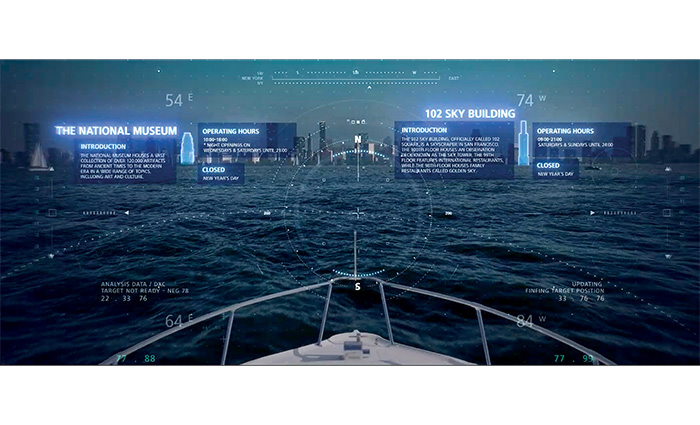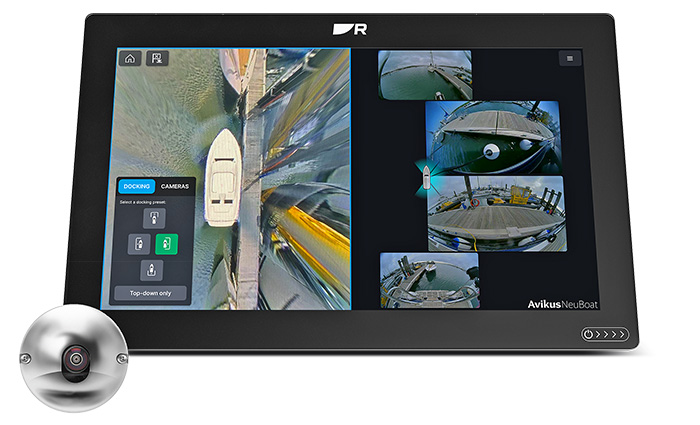Advertisement
Everyone seems to be talking about AI these days. Get ready: It’s moving onto pleasure boats – and coming to a boat show near you this fall

Photo: Avikus
We’ve been reading a lot about “autonomous” motor vehicles and marine vessels that will someday shuttle us all from points A to B while we take in the scenery. The reality is that none of us will be handing over the wheel to a faceless computer any time soon. But AI technology – and the massive amount of data being collected daily by the commercial shipping industry, which has fully embraced it – is now creeping over into recreational boating.
This fall, the Korean autonomous navigation software company Avikus launched its NeuBoat Navi and NeuBoat Dock software that the company says will provide navigation and docking capabilities beyond the monitoring and alerts on today’s pleasure boats. The company says the system can be integrated into any boat that has a joystick system, such as the 29-foot Quicksilver 906 Pilothouse powerboat used as a platform to demonstrate the technology at last winter’s Fort Lauderdale boat show.
Avikus is owned by HD Hyundai, the shipbuilding affiliate to Korean automotive manufacturer Hyundai. Avikus software will be integrated with the auto maker’s AutoEver’s self-driving platform for the marine market. This isn’t a product for retrofitting your boat; the technology will arrive already integrated in some new boats. Avikus says six recreational boat manufacturers have committed to having the product integrated in select new models for 2024.

Volvo Penta’s Assisted Docking system uses software to keep the vessel on the intended course at a set speed and fine-tunes based on conditions. Photo: Volvo Penta
AI today
But first, let’s look at where are we now. Several years ago, Raymarine and Volvo Penta released two modern miracles for docking. Raymarine DockSense was the first assisted docking system for recreational boats and uses small cameras mounted around the boat exterior to “see” things such as other boats, docks, and pilings. Integrated GPS positioning and what the company calls its “attitude heading reference system” work to compensate for the effects of wind and currents while docking.
The system’s Virtual Bumper Zone technology, coupled with the propulsion system, is supposed to prevent the boat from hitting a dock, piling, or another boat. One of our BoatU.S. Magazine editors tried the system several times in benign conditions with no noticeable current, and when it was engaged, he was unable to intentionally “crash” the boat into the dock. It held its position in the middle of the slip.
Next up, Volvo Penta Assisted Docking doesn’t use external components or sensors. Instead, its docking software integrates with Volvo’s Electronic Vessel Control and Dynamic Positioning System. Using a joystick control connected to the required IPS pod drive, the skipper sets an intended speed and course. If variables such as wind or current push the vessel off course, the docking system is supposed to compensate so the boat follows the captain’s original set directions by calculating drive angles and thrust, then acts on the drift picked up by GPS and moves the boat back to its intended course – constantly fine-tuning the steering angles and thrust. At any time, if the captain releases the joystick, the boat instantly pauses in the water and actively holds its position, allowing the skipper to regroup. Unlike the Raymarine product, Volvo Penta offers no virtual bumper; it’s on the skipper to know when to stop.
The Raymarine and Volvo Penta assisted docking systems, which have been on the market for several years, will have competition in the coming months from two other behemoths. Brunswick (the largest U.S. boatbuilder with brands including Sea Ray, Boston Whaler, Bayliner, and Mercury Marine) is introducing a docking system this year, according to Lee Gordon, vice president of public relations and communications. Also, Ben Speciale, president of Yamaha U.S. Marine, recently announced his company will introduce an outboard-based docking system in 2024.
These are all assisted docking systems that help boaters perform one of the more anxiety-inducing tasks of boating. Brunswick’s still-unnamed autonomous docking system (more on that to come soon) can undock and move a boat into open water, but even that advanced system won’t assist a skipper while driving.
The next big thing?
The companies collaborating on the NeuBoat project say their new AI software is a different animal altogether, one that will safely guide a skipper from here to there with an “intelligence” never before integrated on a pleasure boat. The chartplotter cartography and skipper’s selected route, radar, and AIS systems will be paired with onboard cameras and a human-programmed “brain” that they say can distinguish, for example, a swimmer from a sailboat, a buoy from a bowrider, and then signal the skipper and make a safe and correct reaction if the skipper does not. How? The system, they claim, is “taught” to distinguish objects by their Avikus staff, who literally upload hundreds of thousands of images of objects commonly found on the water, with each specifically identified. Avikus claims that once the system has enough identified images, it can start to recognize patterns and classify new images in real-time live video.
“Knowing what the obstacle is allows the algorithm to determine the best way to respond to a collision risk and also to follow standardized collision regulations, such as giving way to a sailing vessel,” says Jamie Cox, director of product management at Raymarine, which is partnering with Avikus on this autonomous navigation project.
This artificial “knowledge” will come integrated into its navigation system, along with Raymarine’s Clearcruise technology, which the company describes as an “augmented reality” system that overlays chart objects and AIS targets on a video stream to provide an artificially enhanced view from any camera position on the vessel – just like the 360-degree camera views found on some Nissan, Volvo, Tesla, and other automobile models.
“It’s a fusion of systems,” Cox explains. “A radar might not always pick up a target, or a boat might not have AIS transmitting. But the camera, which also has chart cartography at its disposal, fills the gap. Because of the chart, plus all the visual knowledge, it will know to not take the boat into an area that’s too shallow or into the areas that are exclusion zones.” That’s a lot to ask and puts a lot at stake.
All “autonomous” vessels are not alike. Under this first Avikus system, the AI-based obstacle detection and collision avoidance consists of overlaid radar, forward-facing camera, and a Laser Detection and Ranging (LADAR) sensor that uses light to measure ranges. The company’s goal for its “AI-trained system” is to process and categorize that information and alert the captain – but it will also actively change course to avoid a collision. The captain can assume control at any point – just as with autopilot systems. When the destination is reached, the system will also provide docking and undocking assistance, according to Avikus.

Avikus’s technology provides a 360-degree bird’s-eye view of the vessel through an Axiom chart plotter to assist in tight-quarters maneuvering and docking. Photo: Avikus
The human factor
It’s not clear how AI-controlled boats will meet the U.S. Coast Guard’s Rule 5, which requires that every vessel at all times “maintain a proper look-out by sight and hearing as well as by all available means appropriate in the prevailing circumstances and conditions so as to make a full appraisal of the situation and of the risk of collision.”
When electronics fail, as they inevitably do, Cox reiterates that the human factor must remain a critical part of the boating experience.
“Just like a passenger jet that still needs human pilots or a Tesla that still needs a driver, you need someone on board capable of navigating and of docking the boat manually.”
“Smart” boats sound thrilling, but there’s much to consider when talking about how much control we should hand over to navigation systems dependent on cameras or GPS data that can and does become disrupted, or when, for safety reasons, we might suddenly need to go where the system doesn’t want us to go.
Boats and boaters operate on a much more challenging and continuously changing environment than the cars using today’s lane-guidance technology. Roads are stable and fixed surfaces, with usually well-defined lanes and edges. Continuous signage warns of dangers and navigation decision points. Drivers are trained and licensed. Boating on open water is a far more challenging world that requires quick decision-making by the skipper, and it remains to be seen how marine AI will perform in bad weather or poor-to-zero visibility.
Lots to think about
We’re living during a time where exciting technology is evolving faster than ever – sometimes faster than government policy, laws, and public understanding can keep pace. Until it can, questions arise, such as how often will the critical, ever-changing navigation information guiding your boat’s artificial intelligence be updated, and by whom? BoatU.S. Magazine will follow and report on marine AI developments in the months and years ahead – as always, with a sharp eye for your safety on the water.
